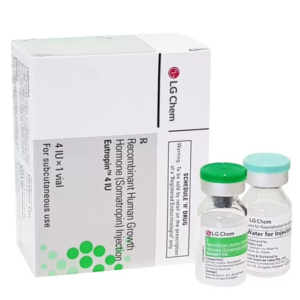$354.00
Singanitropin is a valuable therapeutic option for treating growth hormone deficiencies and related conditions under the supervision of a qualified healthcare provider. While it offers significant benefits in appropriate medical contexts, it should only be used as prescribed to avoid potential risks and side effects. Always consult with a healthcare professional for proper diagnosis, treatment planning, and monitoring when considering Singanitropin therapy.
Singanitropin
Singanitropin is a brand of human growth hormone (HGH) produced using recombinant DNA technology. It is primarily used for therapeutic purposes related to growth deficiencies and certain medical conditions. Here’s an overview of Singanitropin:
What is Singanitropin?
Singanitropin is a synthetic form of human growth hormone (HGH) that mimics the naturally occurring hormone produced by the pituitary gland. It is manufactured using recombinant DNA technology, ensuring it is identical to human HGH in structure and function.
Medical Uses
Singanitropin is prescribed for various medical conditions, including:
- Growth Hormone Deficiency: It is primarily used to treat children and adults who have growth hormone deficiency (GHD). In children, GHD can lead to short stature if untreated, while adults may experience changes in body composition, metabolism, and overall well-being.
- Turner Syndrome: Singanitropin is also indicated for the treatment of Turner syndrome, a genetic disorder affecting females that results in short stature and other health issues.
- Chronic Kidney Disease: Patients with chronic kidney disease often suffer from growth hormone deficiency, and Singanitropin may be prescribed to mitigate these effects.
- Muscle Wasting Disorders: In certain cases of severe burns or muscle wasting disorders, Singanitropin may aid in muscle recovery and regeneration.
Administration
Singanitropin is typically administered via subcutaneous injection. The dosage and frequency depend on factors such as the patient’s age, weight, medical condition, and the severity of the growth hormone deficiency. It is essential to follow the dosage instructions provided by a healthcare provider to achieve optimal therapeutic outcomes.
Mechanism of Action
Similar to natural HGH, Singanitropin acts by binding to specific receptors on target cells throughout the body. This interaction triggers a cascade of biological processes that promote growth, cell reproduction, and regeneration.
Side Effects
While generally safe when prescribed and administered correctly, Singanitropin can cause side effects, especially if misused or abused. Common side effects include:
- Injection site reactions: Pain, swelling, or redness at the injection site.
- Joint and muscle pain: Especially at the beginning of treatment.
- Edema: Swelling caused by fluid retention.
- Carpal tunnel syndrome: Numbness or tingling sensation in the hands and wrists.
- Headaches and nausea are also possible.
Contraindications
Singanitropin should not be used in patients with active malignancy, severe respiratory diseases, or those allergic to any of its components. It is essential to consult with a healthcare professional before starting Singanitropin therapy to ensure it is suitable and safe for the individual.
3 reviews for Singanitropin
There are no reviews yet.




![GENOTROPO® Somatropin [RDNA Origin] for Injection](https://steroidsonlineshop.com/wp-content/uploads/2024/07/geno-300x300.png)








Be the first to review “Singanitropin”